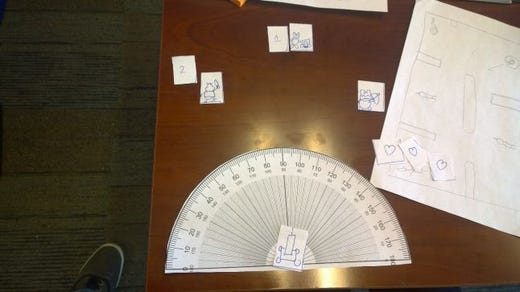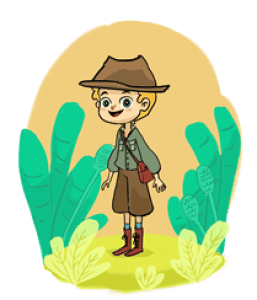At Carnegie Mellon's Entertainment Technology Center (ETC) multi-disciplinary teams work on projects over a semester to create an artifact. While attending the ETC I was the primary designer on the project which created Angle Jungle.
 Angle Jungle is an award winning educational puzzle game for fourth to sixth graders studying geometry. At the start of development our requirements were up in the air. After discussions with our client we settled on the following objectives:
Angle Jungle is an award winning educational puzzle game for fourth to sixth graders studying geometry. At the start of development our requirements were up in the air. After discussions with our client we settled on the following objectives:
Create an experience involving angles.
Integrate the protractor tool.
Design
Our ideation process began with brainstorming based on the objectives of our project. We then created a number of paper prototypes.

Paper Prototype 4 - Angle Ninja
From our paper prototypes, the more successfully strains were refined based on feedback.

Pirates Life Paper V1
In parallel we began the process of creating digital prototypes based off these paper prototypes.

Pirates Life Digital V1
Our breakthrough moment came when Jesse Schell, a faculty member at the ETC, posed to us that though these games used angles, both could be played without thinking about angles. We needed to make an angles essential experience. This priceless notion lead us to create Angle Jungle's progenitor which we called Treasure Hunter.

Treasure Hunter Paper V1
Treasure Hunters mechanic encoded the relationship between the numeric and spatial representation of angles. This was achieved by having players use numeric representations to create spatial representations in-order to solve a puzzle. We believed this embodied a system where angles were essential. We then began refining Treasure Hunter.

Treasure Hunter Paper V2
After positive feedback from playtesting we next created a digital prototype.
<iframe title="Treasure Hunter - Old Version" src="//www.youtube.com/embed/JuK02fMNnmU?enablejsapi=1&origin=https%3A%2F%2Fwww.gamedeveloper.com" height="360px" width="100%" data-testid="iframe" loading="lazy" scrolling="auto" class="optanon-category-C0004 ot-vscat-C0004 " data-gtm-yt-inspected-91172384_163="true" id="840986151" data-gtm-yt-inspected-91172384_165="true" data-gtm-yt-inspected-113="true"></iframe>In the above video players slot numeric values into a beam maker which creates a spatial value. A certain spatial value is required to hit an objective to solve a puzzle and receive treasure. This digital prototype then went through many more iterations.
<iframe title="Embedded content" src="//www.youtube.com/embed/fiWYFbvJp8s?enablejsapi=1&origin=https%3A%2F%2Fwww.gamedeveloper.com" height="360px" width="100%" data-testid="iframe" loading="lazy" scrolling="auto" data-gtm-yt-inspected-91172384_163="true" id="327974445" class="optanon-category-C0004 ot-vscat-C0004 " data-gtm-yt-inspected-91172384_165="true" data-gtm-yt-inspected-113="true"></iframe>At this point in development we had the foundations for an experience. What was needed next was to design that experience.
Experience Crafting
How does one go about creating an experience? There are infinite ways, but we began with considering the difficulty curve within our experience.
Difficulty Curve

The above graph is an abstract difficulty curve which displays a sequence of tense and release cycles of increasing difficulty. This curve would form the underlying foundation of our experience.
Gameplay Elements
With an idea of what we wanted the experience to look like, next we conceptualized the elements within the greater experience. The inspiration for this process came from a number of sources including the learning materials of our target demographic.

Our aim was essentially to gamify our target demographics learning material. We would achieve this through gameplay elements which attempted to capture aspects of the kind of problems they faced in the classroom. These gameplay elements would form the core components of the experience.

More Motivation
Whilst conceptualizing our gameplay elements we also considered the possibility that the puzzle may not be intrinsically motivating enough for players. Therefore we created two additional supporting motivational factors.
Supporting Actor
A gender-neutral character that needed assistance (inspired by Jesse Schell's Lens of Help). Given the use of supporting characters in educational experiences is common, and there exists research on the potential beneficial effects for players. We hoped this would augment learning within our experience.

Golden Expectations
In addition we created The Cabin. The Cabin would contain rewards in the form of treasures and trophies. The Cabin would act as motivational element by creating Golden Expectations (expectation of rewards) through the aesthetic use of empty shelves as well as serve as a measure of game progress.

We also recognized the need to space out our rewards for better impact. We therefore arranged rewards into evenly spaced intervals.

All Together
Together these pieces could further flesh out an abstract difficulty curve of the experience. The peaks of our difficulty curve would now commonly be followed by the introduction of gameplay elements with dips being periods of rest at The Cabin.

The experience needed more though, it cried out for substance in the form of puzzle content.
Transformational Puzzle Complexity
With a high-level view, and the fundamental elements of the experience in mind we went about crafting a set of transformational puzzles.

This process resulted in a jumbled pile of puzzles. This was a good first step, but it did not fit the experience structure we wanted. We therefore turned to a mighty tool. The spreadsheet.

The spreadsheet consisted of columns of each gameplay element which we incrementally increased to raise puzzle complexity. This tool complemented the design process as we created more puzzles based on these new complexity constraints.
Two additional considerations came to mind during this process:
Include drops in puzzle complexity when introducing new gameplay elements to allow for more effective tutorials.
Have the majority of learning occur early when complexity is low.
The result of this work was a structure of thirty levels which we then playtested.
<iframe title="Embedded content" src="//www.youtube.com/embed/y6wa9RCSZJA?enablejsapi=1&origin=https%3A%2F%2Fwww.gamedeveloper.com" height="360px" width="100%" data-testid="iframe" loading="lazy" scrolling="auto" data-gtm-yt-inspected-91172384_163="true" id="972575365" class="optanon-category-C0004 ot-vscat-C0004 " data-gtm-yt-inspected-91172384_165="true" data-gtm-yt-inspected-113="true"></iframe>Although initial playtests were largely positive they revealed two design issues:


































